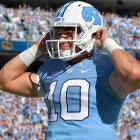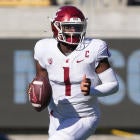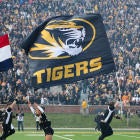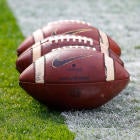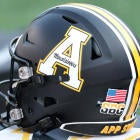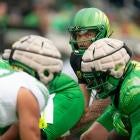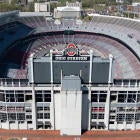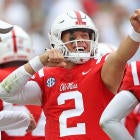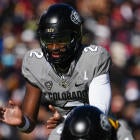Please don’t blame Mitch Trubisky. It’s not the North Carolina signal caller’s fault that he’s the least-experienced top-of-the-draft quarterback in recent memory.
It was the NFL that shot him back a first-round draft projection after all of 13 career starts. It was Peyton Manning and Andrew Luck -- two legends who each stayed in school four years -- who counseled him.
Trubisky decided to come out after his junior season.
It’s not Trubisky’s fault he is part of what is considered an average quarterback draft. Try to forget the ACC’s third-team quarterback is causing part of this stir.
Some team is going to make a kid from a top-five basketball school the face of its NFL program.
“It flies against everything that we’ve experienced,” NFL personnel guru Gil Brandt said.
Actually, the experience is just beginning Tuesday at the NFL combine. Scouts and GMs and coaches can’t wait to wrap their minds and stopwatches around Trubisky.
Too soon for … everything?
“I think he struggled with the decision [to come out],” UNC coach Larry Fedora said, “because in his heart he needed to come back and get a year of experience as a starter. …
“The track record of guys is the fewer games they start, the fewer games they last.”
And that’s from the man who told Trubisky, “He wasn’t going to disappoint me either way.”
This could be a one off or a whole new draft world. If you’re thinking traditional football brand, North Carolina has had exactly one quarterback drafted in the past 42 years (T.J. Yates, fifth round, 2011).
But in some order, Clemson’s Deshaun Watson and Trubisky are widely considered the top two quarterbacks in the draft. CBS Sports’ Rob Rang has both in the top 10 of his latest mock draft.
The NFL craves certainty. Watson has his flaws, but he also has his snaps -- an NCAA-leading 744 plays in 2016 alone -- plus two ACC titles, a national championship and a reputation as an Alabama killer.
Trubisky? UNC went 8-5 with him throwing for 3,748 yards and 30 touchdowns. He finished in the top 11 nationally in accuracy, yards and passer rating. Fedora says his guy can make every throw. Rang says Trubisky has “great pocket movement.”
“Look at the rest of the quarterbacks in the draft right now. They’re all going to require time,” Rang added.
There is not much of a template for taking this leap. The average number of college starts for the top three quarterbacks taken the past five seasons is 32.
Included in that list are three Heisman Trophy winners (Jameis Winston, Marcus Mariota, Johnny Manziel) as well as the likes of Garrett Grayson (Colorado State) and Mike Glennon (NC State).
When it comes to experience, there are few comps for a quarterback rated this high in the draft. Cam Newton had only 14 career starts at Auburn after winning a national championship as a starter in junior college. But he was also the game’s best player (2010 Heisman) and No. 1 overall pick in 2011.
Carson Wentz last year came from FCS North Dakota State. But even through injuries, Wentz arrived with the Eagles having started 22 games (winning 19).
Miami’s Ryan Tannehill switched from receiver to quarterback during his junior year at Texas A&M. He still made 19 career starts. A better comparison might be Denver’s Trevor Siemian, who came to the NFL starting only 14 of 44 games at Northwestern. Except that Siemian was a seventh-round pick, not a potential franchise cornerstone.
None of it compares to this draft stew created by an average quarterback class and the NFL mindset itself. Any general manager knows the blowback from not taking the Trubisky who blows up could be worse than taking the Trubisky who tanks.
“This may turn out to be as good as any,” Brandt said, “or it might be everybody saying, ‘That was the worst quarterback draft ever.’”

Trubisky grew up in Mentor, Ohio, about 30 minutes from Cleveland. Jim Tressel’s dad used to coach at Mentor High. Trubisky was bound to be a Buckeye, until Ohio State plucked J.T. Barrett out of Wichita Falls, Texas.
Trubisky then patiently waited behind Marquis Williams at North Carolina for two seasons. Even last season, he was easy to overlook. Trubisky played in a conference with a national champion (Watson) and the Heisman winner (Louisville’s Lamar Jackson).
“He was asked to make multiple reads,” Rang said. “He was asked to throw it all over the field. Usually for a young quarterback with a lack of experience, usually they get the deer-in-the-headlights look.”
This just might be where the ABA was 40 years ago and what the NBA has become -- drafting prospects “on the come.” That is, taking guys before they’re ready in the hope they ripen into consistent contributors as pros.
There’s a 6-foot-4 eighth-grade quarterback out there named Aaron McLaughlin who has multiple offers from around the country. The combination of the position, its importance and breathless talent evaluators has brought us to this moment.
Jared Goff -- No. 1 overall in 2016 -- was the first Cal quarterback drafted since Aaron Rodgers in 2005. Wentz from a skinny high school player shooting coyotes in his spare time to the No. 2 quarterback taken.
“The spread offense has leveled the playing field a little bit,” Rang said. “Teams are able to put up a lot of points and don’t have to have the five-star quarterback.”
But that doesn’t explain Mike Leach, who hasn’t had one of his Air Raid quarterbacks stick for long in the NFL. By extension, that puts Texas Tech’s Patrick Mahomes on the clock. Red Raiders coach Kliff Kingsbury played for Leach and runs a similar version of the Air Raid.
Notre Dame’s Brian Kelly has produced one NFL quarterback (Tony Pike, Cincinnati) in a career that has spanned a quarter century.
That could change with Deshone Kizer.
Or not.
“It’s a lean year,” Rang said.
“I kind of like the Clemson quarterback myself,” Brandt said. “We try to find out what we can find out wrong with a guy instead of saying, ‘This is a guy who played pretty good against top teams.’”
Suddenly, then, 13 career starts don’t look so lean.
“I feel fairly confident he can be a future franchise quarterback [but] that’s the question,” Rang said of Trubisky. “The NFL is such a what-can-you-do-for-me-right-now business.
Fedora took advantage of his relationship with Archie Manning to get to Peyton. Fedora had recruited Luck. Both quarterbacks agreed to speak to Trubisky.
Peyton Manning had stayed all four years at Tennessee. Luck was a redshirt junior when he left for the NFL after the 2011 season. Their discussions remain a secret.
“They went beyond the call of duty in helping him,” Fedora said. “That was very beneficial for him.
“I can tell you this: Mitch had a notebook. He had pages upon pages of notes he kept from each of them.”
This is the time of year, though, when the Underwear Olympics (aka the NFL combine) matter more than anything. NFL types want to see if Trubisky is indeed 6-feet-3, as advertised.
They want to see that arm strength, that accuracy (almost 70 percent the past two seasons). They want to know if he is more overachiever like Dak Prescott, who stayed five years at Mississippi State, or a really quick learner.
“That’s like a guy being in third grade … saying he really understands defenses,” Brandt said. “All the sudden the next move is to MIT as a graduate student.”
Whatever you do, don’t blame Mitch Trubisky.
“When we came down to it,” Fedora reminded, “his grade came back as a first rounder.”













